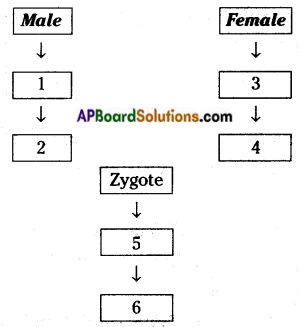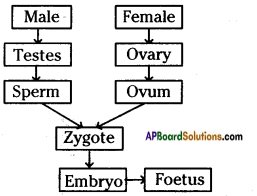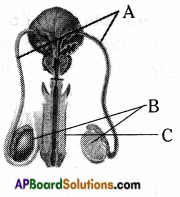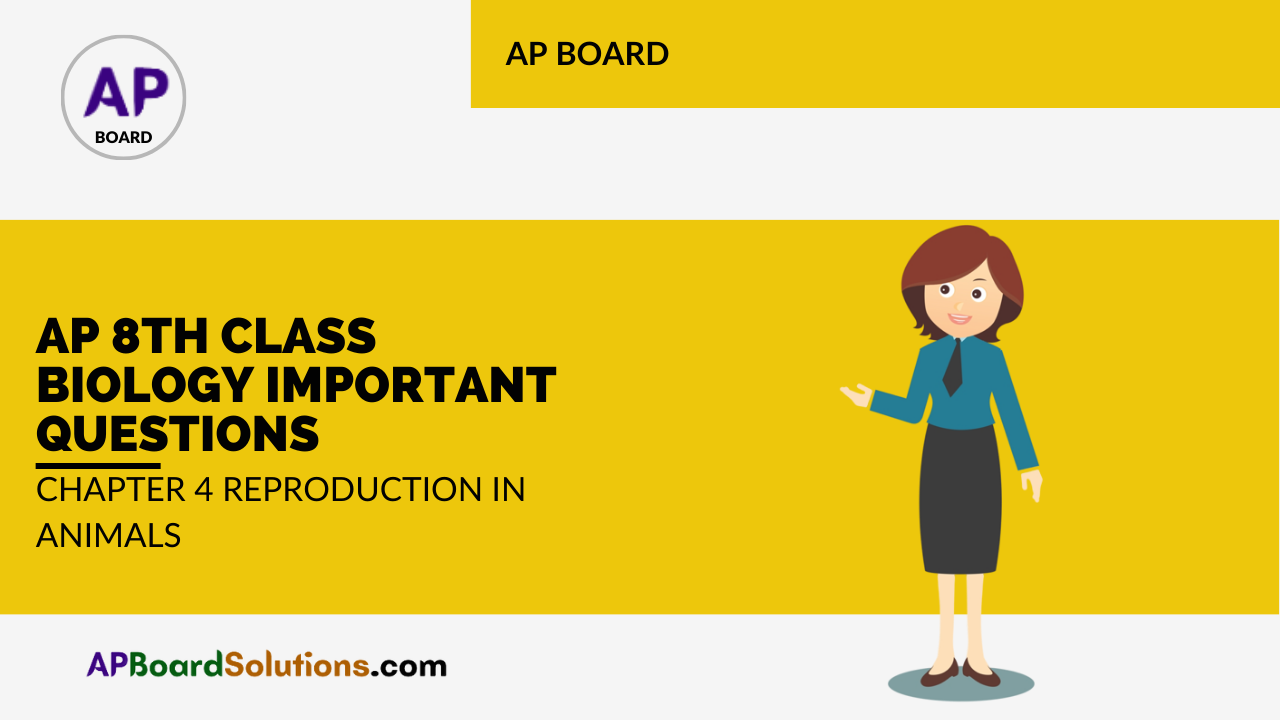These AP 8th Class Biology Important Questions 4th Lesson Reproduction in Animals will help students prepare well for the exams.
AP State Syllabus 8th Class Biology 4th Lesson Important Questions and Answers Reproduction in Animals
8th Class Biology 4th Lesson Reproduction in Animals 1 Mark Important Questions and Answers
Question 1.
What is meant by external fertilization?
Answer:
The process of fertilization that occurs outside of an organism is called External Fertilization. E.g.: Frog, Fish, Star fish etc.
Question 2.
What is meant by Internal Fertilization?
Answer:
The process of fertilization that takes place inside the body of females is called Internal Fertilization. E.g.: Animals, Human beings.
![]()
Question 3.
Which are called Viviparous animals?
Answer:
Animals which give birth to their offsprings are called Viviparous animals. E.g.: Animals, human beings.
Question 4.
What are oviparous animals?
Answer:
Animals which lay eggs are called oviparous animals.
E.g. Hen, Duck, Pigeon etc.
Question 5.
Which is formed by the fusion of male and female gametes?
Answer:
Zygote is formed by the fusion of male and female gametes.
Question 6.
Which gamete is that has a tail and travel to fuse with female gamete?
Answer:
Male gamete or sperm or spermatozoa. The structure of sperm has a head, a middle piece and a tail.
8th Class Biology 4th Lesson Reproduction in Animals 2 Marks Important Questions and Answers
Question 1.
Complete this flow chart.

Answer:
1 – Testes
2 – Sperms
3 – Ovary
4 – Ovum
5 – Embryo
6 – Foetus
![]()
Question 2.
What is meant by cloning if Who invented this?
Answer:
- Cloning is the reproduction of an exact copy of the cell, any other living part or complete organism from somatic cells.
- Cloning of an animal was successfully performed for the first time by lan Wilmut in Scotland.
8th Class Biology 4th Lesson Reproduction in Animals 4 Marks Important Questions and Answers
Question 1.
Complete the cross word puzzle using the hints given below.
Across:
1. The process of the fusion of the gametes.
6. The type of fertilization in hen.
7. The term used for bulges observed on the sides of the body of Hydra.
8. Eggs are produced here.
Down:
2. Sperms are produced in these male reproductive organs.
3. Another term for the fertilized egg.
4. These animals lay eggs.
5. A type of fission

Answer:

![]()
Question 2.
Write a note on “test tube babies”.
Answer:
- The babies who born through IVF (In Vitro Fertilization) technique are called “Test tube babies”.
- In some women, oviducts are blocked due to some reasons. In these cases fertilization will not takes place. Doctors collect freshly released egg and sperms and keep them for few hours.
- In case, fertilization occurs, the zygote is allowed to develop for about a week and then it is placed in the mother’s uterus.
- Babies born through this technique are called ‘Test tube babies’ which does not mean babies growing in test tubes.
8th Class Biology 4th Lesson Reproduction in Animals Important Questions and Answers
Question 1.
What are Oviparous and Viviparous animals ? Write their characters and give some examples.
Answer:
- The animals giving birth to their off springs are called Viviparous animals.
- The animals which lay eggs are called Oviparous animals.
- Viviparous animals have epidermal hair on their skin and external ears. Examples are cow, elephant, dog, etc.
- Oviparous animals do not have epidermal hair or external ears. Examples are fish, frog, crow, peacock, snake, lizard etc.
Question 2.
Kshitija found a fish like larva and put it in an aquarium supposing it as a fish. What would she find after some days?
Answer:
- Kshitija had brought tadpole larva, which looks like a fish. It was the larva of the frog.
- After somedays, this tadpole larva undergoes metamorphosis and develops into a frog.
- Hence, Kshitija would observe a frog in place of tadpole larva after some days in the aquarium.
Question 3.
You want to clarify some doubts about test tube babies what questions do you ask the doctor?
Answer:
- Where do test tube babies born?
- What differences may we find between normally born baby and a test tube baby?
- What problems will test tube babies face in their life?
- Why people have so many doubts about test tube babies?
Question 4.
Draw a neat labelled diagram of a human sperm. Fill the following table:
| Name of the organ | Function |
| Tail | |
| Mitochondria | |
| Head | |
| Middle piece |
Answer:

| Name of the part | Function |
| Tail | Helps in the movements of the sperm. |
| Mitochondria | Releases energy for the movements of the sperm cell and also provides energy for the penetration of sperm into Ovum. |
| Head | Helps in the process of fertilization. |
| Middle piece | It is the site of mitochondria which are the power houses of the cell. |
Question 5.
Latha draw the following flow chart of Human reproduction like this. Is it correct or not.
If not, draw a correct one.

Answer:

Question 6.
What are the differences you observed in the reproduction of Amoeba and frog?
Answer:
| Reproduction in Amoeba | Reproduction in Frog |
| 1. Asexual mode of reproduction takes place in Amoeba. | 1. Sexual mode of reproduction takes place ts Frog. |
| 2. Fusion of garnets will not occur. | 2. Fusion of garnets takes place. |
| 3. Through binary fission or multiple fission (during unfavourable conditions) daughter amoebas are formed. | 3. Through external fertilization, many offsprings will take birth in water. |
| 4. Daughter amoebas formed during binary fission, completely resemble their mother. | 4. Offsprings formed exhibit variations. |
| 5. Mother Amoeba will extinct sifter binary fission. | 5. Mother frog will not extinct after external fertilization. |
Question 7.
Write the apparatus used in the project work of observing the life cycle of frog.
Answer:
To conduct this project we need,
- Wide mouth transparent bottle/tube
- Transparent glass
- Dropper
- Petridish
- Some pebbles
- Magnifying glass
Question 8.
Fill in the blanks with the correct terms.
The main male reproductive organs are A and in females are B. A and B release some cells respectively known as C and D. The fusion of C and D is known as E. E results in the formation of F. F gradually develops into a G and finally becomes a H.
Answer:
The main male reproductive organs are Testes and in females are Ovary. Testes and Ovary release some cells respectively known as Sperm cells and Ova. The fusion of Sperm cells and Ova is known as Fertilization. Fertilization results in the formation of Zygote. Zygote gradually develops into a Embryo and finally becomes a Foetus.
Question 9.
Observe this diagram and answer the questions.

a) The diagram belongs to which system?
b) Write the A, B, C in the above diagram.
c) What produces the “B” part?
d) What is function of Part “A”?
Answer:
a) Male reproductive system in human beings.
b) A – Seminal ducts B – Testes C – Penis
c) Sperm cells
d) This duct connects each testes to the urethra. They transport sperms into the penis.
Question 10.
Look at the picture and answer the questions.

a) Which system does the picture belong to?
b) What is “A”? What is produced here?
c) What is “B”?
d) What happens when fallopian tubes are closed?
Answer:
a) Female reproductive system in human beings.
b) Ovary
c) Uterus
d) Fertilization will not take place.
Question 11.
What happens to a female body when ovulation stops forever?
Answer:
a) If ovulation stops in females, menstrual changes do not occur in female body. This stage is known as ‘menopause’.
b) As ovum is not released, there is no chance of pregnancy in this stage.
Question 12.
Label the parts of female reproductive system and answer the following questions.

a) In which part of the female reproductive system does fertilization occur?
b) What is the function of the part labelled as 2?
Answer:
Labelled parts :
- Fallopian Tube
- Ovary
- Uterus
- Fallopian tube
- Releasing ova
